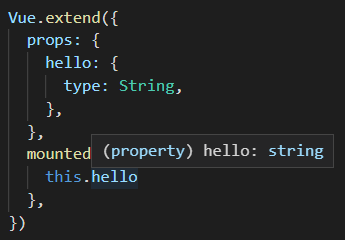问题背景
在使用 Vue + TypeScript 的时候,应该都会有个疑问,这些选项都是怎么推导出来的?特别是 props 这个选项,有着好几种形式:
1
2
3
4
5
6
7
8
9
10
11
12
13
14
15
16
17
18
19
20
|
props: ['hello']
props: {
hello: String,
}
props: {
hello: [String, Boolean],
}
props: {
hello: {
type: String,
default: 'hello',
},
}
|
有着这么多种形式,最后还能在其他地方推导出正确的类型

怎么做到的?
查看源码
我们从 Vue.extend 点进去,找到 vue.d.ts 中定义的 extend :
1
2
3
4
5
| export interface VueConstructor<V extends Vue = Vue> {
extend<Data, Methods, Computed, Props>(options?: ThisTypedComponentOptionsWithRecordProps<V, Data, Methods, Computed, Props>): ExtendedVue<V, Data, Methods, Computed, Props>;
}
|
顺着 Props 相关的类型,找到 vue 的 options.d.ts 文件中的 ComponentOptions 接口,这是我们使用 Vue.extend 时传入选项的接口。
可以看到 props?: PropsDef;
我们顺着这个 PropsDef 把 Props 相关的定义都提取出来:
1
2
3
4
5
6
7
8
9
10
11
12
13
14
15
16
17
18
19
20
21
22
23
24
25
26
| export type Prop<T> = { (): T } | { new(...args: any[]): T & object } | { new(...args: string[]): Function }
export type PropType<T> = Prop<T> | Prop<T>[];
export type PropValidator<T> = PropOptions<T> | PropType<T>;
export interface PropOptions<T=any> {
type?: PropType<T>;
required?: boolean;
default?: T | null | undefined | (() => T | null | undefined);
validator?(value: T): boolean;
}
export type RecordPropsDefinition<T> = {
[K in keyof T]: PropValidator<T[K]>
}
export type ArrayPropsDefinition<T> = (keyof T)[];
export type PropsDefinition<T> = ArrayPropsDefinition<T> | RecordPropsDefinition<T>;
export interface ComponentOptions<
// ...
PropsDef=PropsDefinition<DefaultProps>,
Props=DefaultProps> {
props?: PropsDef;
}
|
简化代码
上边源码看起来还是有点多,我这边大概理解了推导过程,所以写一个简化版的便于理解,只考虑 props 为对象的情况:
1
2
3
4
5
| Vue.extend({
props: {
test: String,
}
})
|
简化的类型代码:
1
2
3
4
5
6
7
8
9
10
11
12
13
14
15
16
17
| type Prop<T> = () => T
type PropDef<T> = {
[K in keyof T]: Prop<T[K]>
}
interface PropsConstructor {
extend<Prop>(options?: PropDef<Prop>): Prop
}
declare const Props: PropsConstructor
const props = Props.extend({
test: String,
})
|
把上述简化的代码贴到 VSCode ,把鼠标移到 const props 上,可以发现正确推导出了 { test: string } 。
怎么做到的呢?这里我之前犯了个错误,把 Prop 这个类型当成是我们传进去的对象了,所以一直没法理解。
而实际上,PropDef<Prop> 才是我们传进去的类型,这边是 通过 PropDef<Prop> 推导出了 Prop
我们把 { test: string } 从上往下代入类型中,就是:
1
2
3
4
5
6
7
8
9
10
11
12
13
| type Prop<string> = () => string
type PropDef<{
test: string,
}> = {
test: Prop<string>;
}
interface PropsConstructor {
extend<{ test: string }>(options?: PropDef<{ test: string }>): { test: string }
}
|
代入后,不知各位会不会清楚一些。
这边的重点就是 通过 PropDef<Prop> 推导出了 Prop
我们写 Vue.extend 的时候定义的是 PropDef<Prop> ,而 Prop 则是通过 TypeScript 推导出来的,因此我们在其他地方才能获得正确的类型。
其他情况
如果理解了上面那种情况,那其他情况其实就比较好理解了。
我们看到 vue 里面有这样一条类型定义:
1
| export type PropsDefinition<T> = ArrayPropsDefinition<T> | RecordPropsDefinition<T>;
|
显然,这是区分了 props 是数组跟对象的情况。
数组
首先看数组:
1
| export type ArrayPropsDefinition<T> = (keyof T)[];
|
数组的情况比较简单,假设我们传入的是 ['test'] ,那么就直接对应了这个类型,在 extend 时会转为一个对象,类型都是 any ,即 { test: any }。
对象
然后是对象:
1
2
3
4
5
6
7
| export type PropType<T> = Prop<T> | Prop<T>[];
export type PropValidator<T> = PropOptions<T> | PropType<T>;
export type RecordPropsDefinition<T> = {
[K in keyof T]: PropValidator<T[K]>
}
|
这边的 PropType<T> 基本对应了刚刚简化版的情况,不过还加了一个数组的情况,就是:
1
2
3
4
5
6
7
8
9
10
11
| Vue.extend({
props: {
test: String,
},
})
Vue.extend({
props: {
test: [String, Boolean],
},
})
|
对应这两种情况。
最后的 PropOptions<T> 就是对应最复杂的那种情况了:
1
2
3
4
5
6
7
8
| Vue.extend({
props: {
test: {
type: String,
default: 'xxx',
},
},
})
|
这个结构对应 PropOptions<T> :
1
2
3
4
5
6
| export interface PropOptions<T=any> {
type?: PropType<T>;
required?: boolean;
default?: T | null | undefined | (() => T | null | undefined);
validator?(value: T): boolean;
}
|
PropOptions 的那个 T 就是我们最后推导拿到的类型,即 { test: string }
多个 extend 方法的重载
在 vue.d.ts 中,可以看到 VueConstructor 有很多 extend 方法的重载:
1
2
3
4
5
6
7
8
9
10
11
| export interface VueConstructor<V extends Vue = Vue> {
extend<Data, Methods, Computed, PropNames extends string = never>(options?: ThisTypedComponentOptionsWithArrayProps<V, Data, Methods, Computed, PropNames>): ExtendedVue<V, Data, Methods, Computed, Record<PropNames, any>>;
extend<Data, Methods, Computed, Props>(options?: ThisTypedComponentOptionsWithRecordProps<V, Data, Methods, Computed, Props>): ExtendedVue<V, Data, Methods, Computed, Props>;
extend<PropNames extends string = never>(definition: FunctionalComponentOptions<Record<PropNames, any>, PropNames[]>): ExtendedVue<V, {}, {}, {}, Record<PropNames, any>>;
extend<Props>(definition: FunctionalComponentOptions<Props, RecordPropsDefinition<Props>>): ExtendedVue<V, {}, {}, {}, Props>;
extend(options?: ComponentOptions<V>): ExtendedVue<V, {}, {}, {}, {}>;
}
|
这边通过 options 参数的类型,可以看出应对不同 props 形式而做的重载:
1
2
3
4
5
6
7
8
9
10
11
12
13
14
15
16
17
18
19
20
| export interface VueConstructor<V extends Vue = Vue> {
extend<Data, Methods, Computed, PropNames extends string = never>(options?: ThisTypedComponentOptionsWithArrayProps<V, Data, Methods, Computed, PropNames>): ExtendedVue<V, Data, Methods, Computed, Record<PropNames, any>>;
extend<Data, Methods, Computed, Props>(options?: ThisTypedComponentOptionsWithRecordProps<V, Data, Methods, Computed, Props>): ExtendedVue<V, Data, Methods, Computed, Props>;
extend<PropNames extends string = never>(definition: FunctionalComponentOptions<Record<PropNames, any>, PropNames[]>): ExtendedVue<V, {}, {}, {}, Record<PropNames, any>>;
extend<Props>(definition: FunctionalComponentOptions<Props, RecordPropsDefinition<Props>>): ExtendedVue<V, {}, {}, {}, Props>;
extend(options?: ComponentOptions<V>): ExtendedVue<V, {}, {}, {}, {}>;
}
|
结论
通过 PropDef<Prop> 推导出了 Prop
就是本次记录的结论,你在 VueConstructor['extend'] 的多种重载中看到的 Props ,都是已经推导好的类型,而不是用户传进去的代码。
学过 TypeScript 的各位大佬们可能很快就理解了这种用法,我比较迟钝,记录一下hhh。
